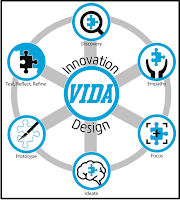 Along with math and design, I also teach 7th grade science
at Vista Innovation and Design Academy (VIDA) which has a learning engine of
design thinking. In this design
challenge, students will be looking at the connections between nutrition, food production, and global climate change. I will be meshing components of nutrition action plans, NGSS and the
VIDA Design Cycle. Through the process, students will be able to tackle either
personal, community, or global issues.
Along with math and design, I also teach 7th grade science
at Vista Innovation and Design Academy (VIDA) which has a learning engine of
design thinking. In this design
challenge, students will be looking at the connections between nutrition, food production, and global climate change. I will be meshing components of nutrition action plans, NGSS and the
VIDA Design Cycle. Through the process, students will be able to tackle either
personal, community, or global issues.
Early in the year we begin the study of climate change by investigating
the Arctic ecosystem and the changes in glaciers and sea ice. We then look at
causality and learn about the chemistry of fossil fuels and how the build-up of
carbon dioxide leads to the greenhouse gas effect. At this point I would
introduce the Understanding Food and Climate Change interactive
guide, and go over the ideas presented in “What is a Food System?” As a
class, we could share about favorite foods and possibly have a debate about
what true California cuisine should look like. This would involve research into
indigenous plants as well as imports that thrive in our climate. Because droughts are an ongoing problem in California,
we could also look at issues related to irrigation and water usage.
To build background knowledge, I will have student work with a
partner to go through the “How Climate Change Affects Our Food System”
portion of the interactive guide. They will draw a model demonstrating their
understanding of the impact in their science journal, and will have the
opportunity to share with the class and refine their ideas. Then, for inspiration,
we will review “How Our Food System Affects Climate Change” and dive into
empathy with other species and future human populations.
In our Design Cycle, the next phase is to define our focus. Here I
will support students to direct their own path and develop a goal. Having
students determine the direction of a design challenge is an important
component of our school culture. These goals could be individual, small group,
community, or global goals. We can chart the importance and difficulty of each
goal to help ensure that each goal is feasible and worthwhile for students. I
will review goals with each student and help them to refine them into clear statements that students can record in
their journals and track.
The next part of our school process involves ideation and
prototyping the student change ideas. For this portion of the design challenge,
our school has a variety of procedures to help facilitate student projects. First,
students will be encouraged to team with other students sharing similar goals, unless
working individually really seems to be a better fit. Then, there are several
scaffolded protocols that students can opt to use to guide them towards their
next steps, and staff members who will take time to help students find and use
the right protocol. Students will have time in class to work on their goals,
and will be encouraged to communicate with their families to enlist help and
support at home. I will also have
students explore the “Promising Strategies for Addressing Climate Change”
in the interactive guide to help them formulate and refine their plans. For
further information I am curating an annotated list of resources, primarily from
the Food and Nutrition Education Resources Database, so that students
can dive deeper into the process. They will also be encouraged to add any
additional resources to the class
database.
Our school culture should make creating a supportive environment for
student change relatively easy. We have experts in a variety of areas in and
around our campus that students could look to for advice and support. One
teacher has developed a hydroponics lab, while another houses aquaponic tanks
in her room. One of our wellness (our version of P.E.) teachers is turning an
unused baseball diamond into a student garden. Our school also houses both a health
aid and one of the district RNs, and both are always willing to support
students in any aspect of their health. Our site and district Nutrition
Services staff are willing to speak with students and listen to their concerns
and ideas. While they can’t always implement the ideas, they will take the time
to explain to reasoning behind any of their practices.
The final step in our process is to reflect and refine. Students
will have several opportunities to present their ideas and progress towards
their goals. They will be encouraged to continually seek feedback and support along
the way. In the Spring, they will have the opportunity to share their ideas
with a public audience at our school’s annual Design Expo.
